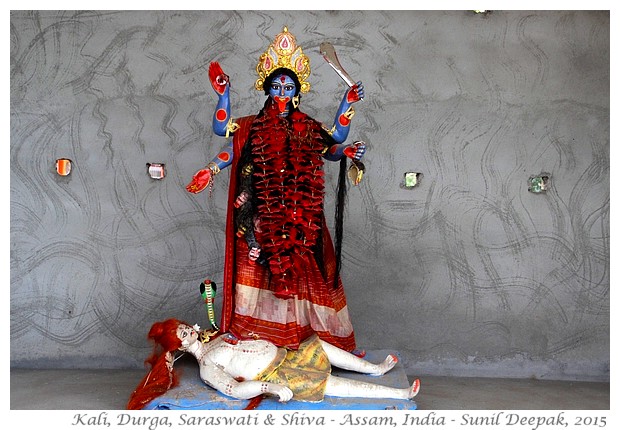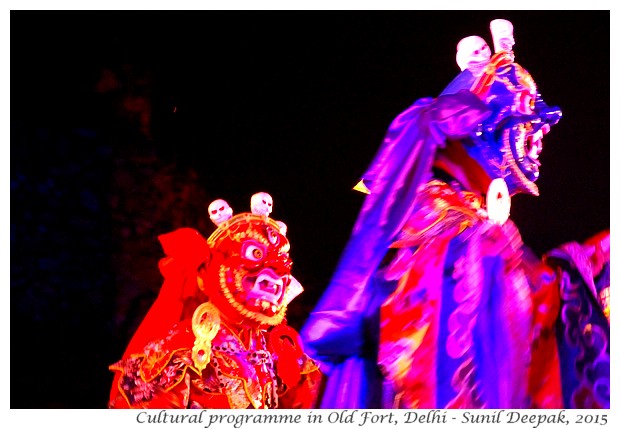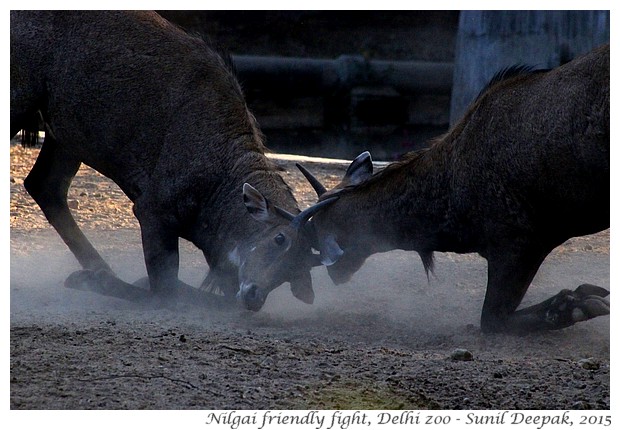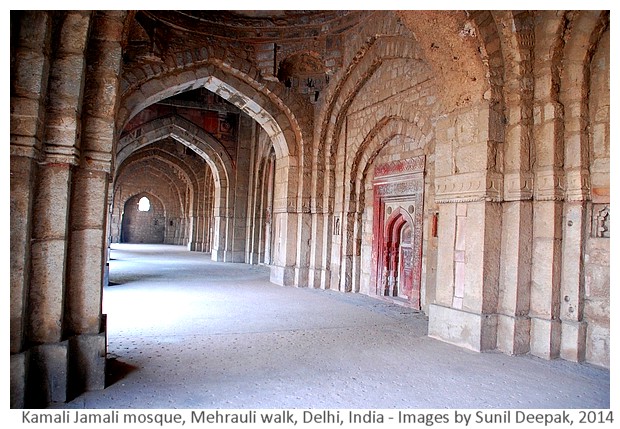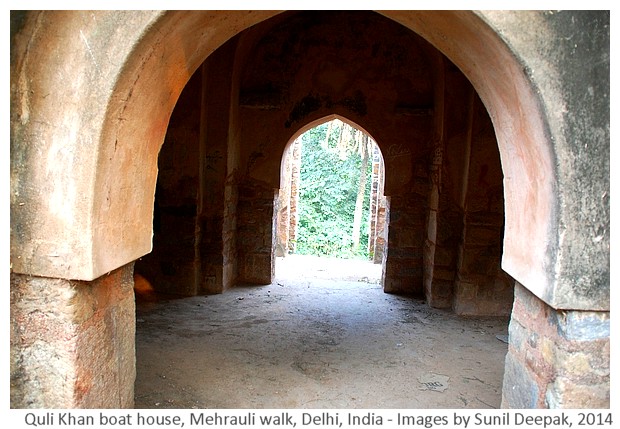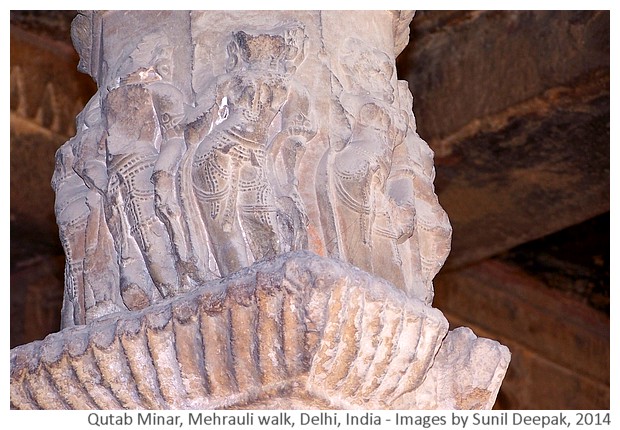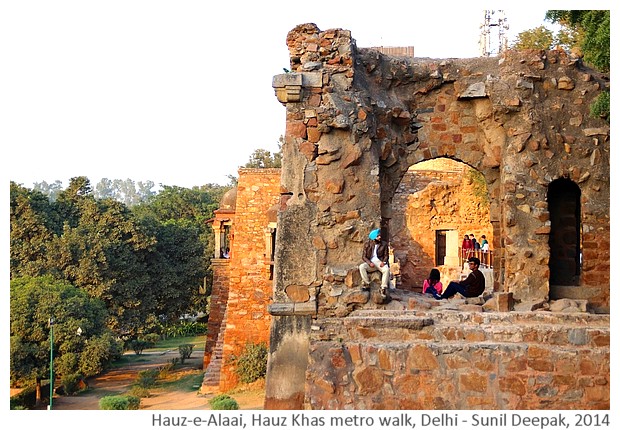Delhi Metro provides a lot of opportunities for discovering the historical heritage of Delhi through walks around the metro stations. This post is about some heritage sites in Mehrauli area of Delhi around the
metro station "Qutab Minar" on the Yellow line.
The image above shows the
tomb of Ghiyasuddin Balban who ruled Delhi for about 20 years in the thirteenth century. It is one of the riches awaiting you on this walk.
DELHI AROUND MEHRAULI
According to the legends, the city of Delhi was first settled in the areas around Old Fort and it was called Indraprastha.
Mehrauli is one of the oldest parts of the city, inhabited at least from 10th century onwards, when Lal Kot fort was built by Tomara kings Surajpal and Anangpal. The name of the city "Dhilli" was given in that period.
The Tomara dynasty ended in 1149 AD when Prithvi Raj Chauhan became the ruler and converted Lal Kot into a new fort called Qila Rai Pithora. Chauhan ruled the city for more than 40 years. Chauhans were defeated by Qutubuddin Aibak around the end of 12th century, who built the well known Qutab Minar in Mehrauli.
Aibaks were replaced by Khilji dynasty and then the Slave dynasty of Mamluks in the 13th century, who continued to live in Mehrauli, though Khilji did initiate the construction of a water reservoir called Hauz-e-Alai to the north, in the area now known as Hauz Khas. Later, as Mughals arrived in Delhi in the 16th century, Delhi moved even further towards north-east, but Mehrauli continued to be inhabited. For example, the last Mughal king Bahadur Shah Zafar had built a palace in Mehrauli and one of his sons was buried here.
1. QUTAB MINAR METRO STATION
Qutab Minar metro station is on the Yellow line of the metro that connects Jahangir Puri in the north-west to Huda city centre in Gurgaon in the south of Delhi. Coming from the city centre Connaught Place, where the metro runs under-ground, "Qutab Minar" is the first over-ground station. The station is situated 2 km from Qutab Minar.
The map below shows the path for this walking tour. Qutab Minar metro station is shown on the bottom of this map (1). The blue dots indicate the path on Anuvrat Road going to Qutab Minar (2), a historical landmark of Delhi.
I preferred to take an auto-rickshaw from the metro station to Qutab Minar, and then walk back towards Mehrauli flower market and the Mehrauli Archeological park. However, if you wish, you can walk the whole way!
2. QUTAB MINAR
When I was a child, it was possible to climb to its top. Going up the narrow stairs going round and round was not an easy trip but I still remember standing on the small terrace at the top and looking out from there. At that time, someone had explained that king Qutubuddin was married to a Hindu queen, who refused to eat without first praying to the river Yamuna. Thus, the king had ordered the building of the tall tower so that his queen could see the river and do her daily prayers.
The history books do not repeat this story any more, so probably it was just a local legend. Another local legend at that time was that the tower was even taller with 2 additional floors and that a plane had crashed into it, destroying the upper 2 stories. Even this story is no longer repeated so I guess it was also an urban legend.
The walls of the tower and other buildings nearby are adorned with words from Koran in Arabic.
The other buildings around the Minar include a couple of mosques, including one with an imposing gate called Alai Darwaza (The gate of god).
One of the courtyards near the Minar has a 4th century iron pillar, made from an alloy in such a way that it does not get rusted. Different legends are linked to this pillar. One legend says that if you stand with your back towards the pillar and then try to reach out and circle it with your arms - if your hands can meet, you will become a king. However, some years ago, the pillar was surrounded by an iron railing so it is not possible to test this legend any more.
Another legend says that this pillar called Killi in the local language, gave the name of Dhilli and then Dilli (Delhi in English) to the city.
Qutab Minar is a World Heritage site of UNESCO.
3. MEHRAULI FLOWER MARKET
As you come out of Qutab Minar and start walking towards the metro station, take the small lane on the right, and it will bring you to the flower market of Mehrauli. The market works mainly early in the morning when retailers from different parts of the city and families preparing for a marriage, come here to buy flowers.
It is a very unassuming street, dusty and full of pot holes, but it has a lot of ambiance.
As you come out of the market on the Anuvrat road, if you are interested, you can climb up the hill across the road to visit the giant Mahavir statue, a contemporary of Buddha, who gave a message of non violence and love towards all living beings. The followers of Mahavir are called Jains, who usually observe strict dietary norms and do not eat any kinds of meat, fish, eggs and even some vegetables such as onions and garlic.
I wanted to spend more time in Mehrauli Archeological park, so I gave a miss to the Mahavir statue, promising myself that soon I will go back there to visit it.
MEHRAULI ARCHEOLOGICAL PARK
The ruins of Mehrauli archeological park surrounded by a forest are one of the most enchanting places of this city. To reach the park, continue on Anavrat road towards the metro station and you will see the park board and gates on your right.
As you enter the park, if you turn towards the right, you will reach the
tomb of king Balban (4) from 13th century, presented in the first image of this post. All around the tomb, there are ruins of old houses and buildings.
A short walk will bring you to the
Jamali Kamali mosque and tombs (5). Sheikh Fazulullah or Jamali was a sufi saint and poet in the 16th century. The tomb was built in 1528 and has two graves - that of Jamali and his close friend Kamali. Some persons believe that Jamali and Kamali were not just friends but also lovers. The tomb has lovely glazed blue coloured tiles.
Across the entrance to the mosque, on a hillock there is a small chhattri (umbrella), built by an Englishman called "
Metcalf's folly". Baron Thomas Theophillus Metcalf was the British Resident in the court of the last Mughal king Bahadur Shah Zafar II and is credited with different buildings in Mehrauli area.
As one proceeds inside the park, some distance down the road is the tomb of Quli Khan, from the time of Mughal emperor Akbar. The tomb building was restored and converted into holiday place called
Dilkhusha by Baron Metcalf, who also built
a boat house (6) near by. The small lake near the boat house is now dry and covered by the forest.
About half a kilometre later, walking on a narrow forest path, you will reach
(7) Rajon ki Baoli (King's stepwell), a famous stepwell built by noble Daulat Khan during the reign of Sikander Lodhi in the 15th century.
Across the entrance to the Baoli, if you climb on the hillock, you will find numerous important looking tombs, indicating that once this was an important place.
Further along the road, you will see other ruins of buildings and tombs, till you reach a small street of Mehrauli residential area. Along a mosque on the right, you will see another old stepwell,
(8) Gandhak ki Baoli (Sulphur well), which is supposed to be a place for miracle cures of illnesses and disabilities. While there, I saw a poor family with their disabled child, going down towards the dirty looking water of this well.
Near by is the
(9) dargah of a Sufi saint Bakhtiar Kaki. People come from far away places to ask favours from this saint.
CHANGES IN RELIGIONS IN MEHRAULI
Before the arrival of the Turks, this part of the city was an important pilgrimage centre for Hindus with different temples. Some of those temples were destroyed and their buildings were used for making the new monuments of the Muslim rulers, as you can see from the following picture of a column in the Qutab Minar courtyard.
Today, Mehrauli is also a symbol of syncretic traditions of Hindus and Muslims. In October every year it celebrates a flower festival called "
Phoolwaalon ki Sair" (The walk of persons carrying flowers) that passes from the ancient Yogmaya temple to the Sufi dargah of Bakhtiar Kaki. This occasion is marked by a lovely cultural programme that runs for 3 days.
Legend has that the ancient
Yogmaya temple, dedicated to the sister of Krishna, is one of the old temples from Mahabharata times. This temple had given the old name of Yoginipura to this part of Delhi. I did not visit this temple this time, but I hope to go back to it soon.
CONCLUSIONS
I was getting late and after the visit to the dargah I decided to walk back through the Mehrauli Archeological park and towards the metro station. The whole walk had taken more than 3 hours. Unfortunately, this meant that I missed out on many other important places in Mehrauli including the Lal Kot walls, Jahaz Mahal, Zafar Mahal, tomb of Adham Khan and Bhul Bhulaiya (maze). To visit all those other places, I needed at least 2 additional hours. So I plan to go back one day and complete this walking tour of Mehrauli.
Thus, if you are planning this walking tour, keep plenty of time, wear comfortable and simple shoes and carry water and other ncessities with you. The whole area is almost wild, that gives it a lovely air, but it means that you will not find any services or shops on the way. In my opinion, it would not be advisable to women travelling alone to attempt this walk - there are just too many lonely stretches.
This walk will take you through a dead city. There is no way to find out the names of the persons who lived and died here or the historical events linked to them. Often you will reach rough paths dividing and going into different directions - it does not matter which path you will take, you will end up with some interesting ruins. Thus, if you like adventure, you will love this walk!
***

